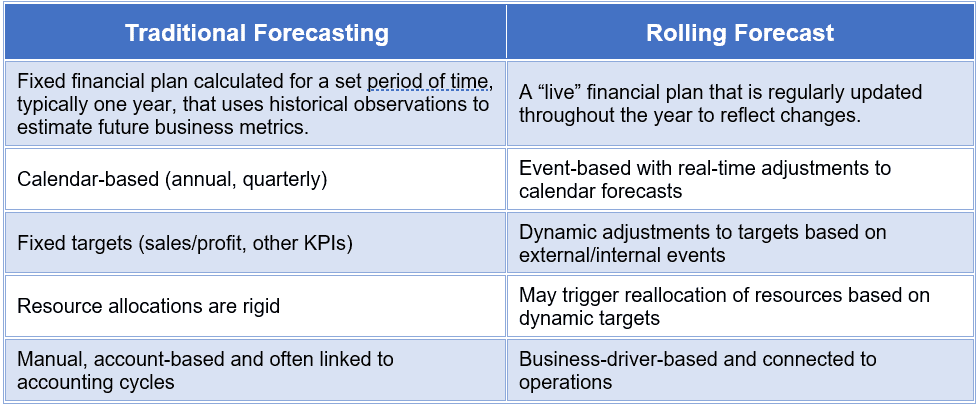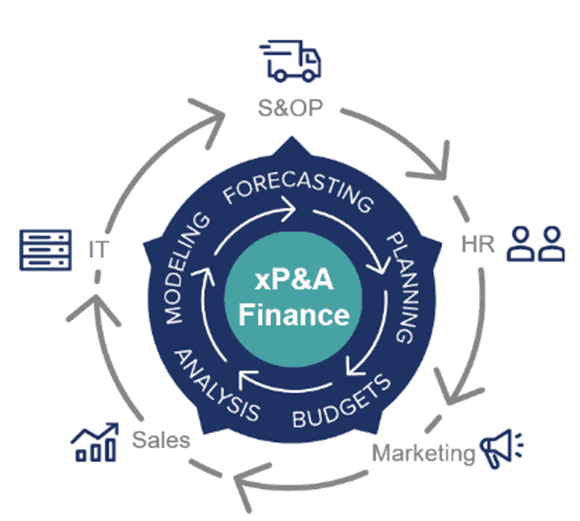Do you know if your organization is using the best budgeting and forecasting process possible? Tried-and-true static budget methods are what many organizations resort to today. But static budgets built within legacy financial forecasting software are not flexible enough to react to what’s happening in the business during the budget period. Meanwhile, rolling forecasts are designed to change and adapt throughout the year, which provide more value if large and sudden changes impact your business. Now is the time to take the best of modern finance planning and extend it across the enterprise through xP&A (extended planning and analysis). Read on to learn more.
Let’s face it, the world is changing rapidly, and organizations face tremendous pressure to evolve with the changes. It’s no longer good enough for Finance and Line of Business leaders to create an annual plan with financial forecasting software and make multiple adjustments throughout the year. Why? Well, as the pace of change increases, annual plans become increasingly less relevant and, in many cases, are completely abandoned by Finance chiefs before the ink even dries.
As Finance transforms into the central hub within an organization, static budgets alone are not sufficient for budgeting, forecasting, and planning. It isn’t that the annual budgeting process isn’t a useful exercise. After all, the process still…
- Plays a key role in transforming business plans into financial goals.
- Remains critical for demonstrating what resources must be deployed and when to make the strategic vision a reality.
- Helps track how actual performance compares to the strategic financial plan.
But static budgets do little to help organizations drive ongoing performance. Why? Well, annual plans are generally reactive to changing conditions. Such plans are also time-consuming to build and update, inflexible and ineffectively utilized – causing employees to lose faith in the budgeting process. The budgeting, planning, and forecasting process is seen as an exercise imposed by Finance and yielding little benefit to operational groups (e.g., Sales, Marketing, Supply Chain).
Albert Einstein perfectly captured why static budgets need to go: “Insanity is doing the same thing over and over and expecting different results.”
Today, Finance chiefs are challenged with helping their organizations break the reliance on annual plans and embracing more agile planning techniques including driver-based planning and rolling forecasts.
Optimizing Day-to-Day Performance
Rolling forecasts (see figure 1) are extremely beneficial for large and dynamic enterprises as financial forecasting software tools to help continually adapt planning processes to actual performance and market trends. How? Rolling forecasts allow for more accurate and multifaceted forecasting by re-calibrating the forecast based on changes in both internal variables (e.g., changing demand volume and pricing), and external factors (e.g., fluctuations in the industry, economy, weather, or geopolitical ecosystem).

Below are a few additional reasons annual plans do little to help manage day-to-day performance:
- Valuable time for managing the organization is squandered on chasing “what happened.” For instance, your April forecast for the rest of the year is already projecting too many variances and will no longer support your well-reasoned annual plan. At this point, most organizations start scrambling to get the forecast “good enough” without knowing what caused the variances that impacted the annual plan. The result is time spent making current numbers fit a stagnant plan rather than making decisions to support organizational strategy and growth.
- Too little attention on moving the strategic needle due to reactively reconciling data against the annual plan. What happens when management asks why certain line items are abnormally high compared to last year? A reactionary response. Rather than focusing on forward-looking insights, you spend the next week chasing down data from multiple systems, merging and validating the data, and finally, reconciling the data to support management reporting. Strategically, nothing gets accomplished, but far too often, organizations find themselves in these reactionary situations.
- Activities to support the plan focus on discussions rather than produce real decisions. Remember when you could establish an annual plan, adhere to it all year and make meaningful adjustments based on forward-thinking decisions? Unfortunately, this idealistic concept is allusive to most organizations. Why? Well, variables like the weather impacting supply chains or downturns in industry-specific demand can kill even the most well-reasoned annual plan on day one. The challenge lies in having a process flexible enough for the onslaught of variables while dealing with an inherently rigid annual plan. A rolling forecast is flexible by nature and can account for organizational challenges – allowing you to produce true insights to make real decisions.
We’ve previously defined a rolling forecast as “a management tool that enables organizations to continuously plan (i.e., forecast) over a set time horizon” vs. a calendar or fiscal year. For example, in a 12-month forecast period, as each month ends, another month will be added. In other words, you’re always forecasting 12 months into the future.
Best practice is to ensure rolling forecasts can extend (e.g., roll) beyond the current calendar or fiscal year-end. Most commonly, rolling forecasts contain a minimum of 12 forecast periods but can also include 18, 24 or more periods depending on the needs and complexity of the organization.
Here’s a summary on the key differences between traditional and rolling forecasts (see Figure 2):

Keep It Simple to Best Solve a Complex Problem
Simplifying how your team approaches forecasting is a keyway to drive efficiency, which is a key driver of value.
Luckily, we previously provided a framework to get you started on the first steps to becoming an agile Finance organization. But there’s an additional accelerator to consider, supercharging accuracy and delivery, with the concept of eXtended Planning and Analysis (xP&A).
The paradigm shift from traditional FP&A to xP&A (see figure 3) offers a way to fully support a rolling forecast by enabling the inclusion of all organizational functions into a cohesive unified process and platform that adjusts to challenges and needs.

According to Gartner [1], by 2024, FP&A is expected to encompass xP&A, a strategy where “x” denotes how the traditional silos separating enterprise financial and operation planning processes are broken down. The result? A new level of transformative business value.
At OneStream, we call this Intelligent Finance.
Learn More
As your FP&A team begins your Rolling Forecast journey towards organizational agility, download BARC’s (Business Application Research Center) latest Future of Planning survey here to learn more and contact OneStream if your organization is ready to make the leap from static planning to agile forecasting
[1] Magic Quadrant for Cloud Financial Planning and Analysis Solutions, Greg Leiter, Robert Anderson, John Van Decker, 6 October 2020
Get Started With a Personal Demo



